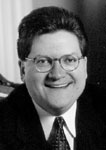Publications
Summer 2003 Newsletter
Speaker Emeritus Hertzberg Brings Record $25 Billion School
Bond To The People
 This
November, Californians approved a $13 billion school construction
bond. Championing the legislation to put the bond on the ballot
was Speaker Emeritus Robert Hertzberg. NSBN is
pleased to present this interview with former Assembly Speaker
Hertzberg in which he discusses the opportunity at hand for the
state, the incentives built into the legislation to promote joint-use
facilities through collaboration across agencies, and why this
effort has the potential to succeed where others have not. This
November, Californians approved a $13 billion school construction
bond. Championing the legislation to put the bond on the ballot
was Speaker Emeritus Robert Hertzberg. NSBN is
pleased to present this interview with former Assembly Speaker
Hertzberg in which he discusses the opportunity at hand for the
state, the incentives built into the legislation to promote joint-use
facilities through collaboration across agencies, and why this
effort has the potential to succeed where others have not.
Bob, why did you choose to champion AB 16, the recent $25 billion
state school bond?
I was very involved in the $9.2 billion school bond that was on
the 1998 ballot. A cornerstone of those discussions was the issue
of school construction and how reform had been bottle-necked in
the Legislature for more than 16 years. AB 16 continues that discussion
and provides a mechanism for addressing that bottleneck by incentivizing
creative and innovative ways of building school facilities.
You talk about AB 16 as a way to address the problems
imbedded in the school facility construction framework. How will
that measure and other subsequent legislation remove those barriers
to build better schools and be true catalysts for neighborhood
revitalization?
Fighting the status quo-particularly in the more populated urban
areas of California-is always difficult. People simply find it
much easier to write next year's check to the same people they
wrote it to last year. That why the "Leave it to Beaver"
approach of school construction has stuck around for so long.
But what this new school bond framework allows is an opportunity
to break from that tradition and truly infuse a new and vibrant
dynamic into our communities. By allowing and incentivizing school
districts to utilize library, park and school bond monies we begin
to unlock the gates that close our school campuses at 3 o'clock
and begin to make our schools the center of neighborhoods. This
will truly invigorate our communities in ways that should have
happened long ago.
The argument over the years has been that each bond measure-school,
park and library-has its own silo-like rules, regulations, benchmarks
and approval processes that create almost insurmountable disincentives
to collaborate with other agencies and the community. What is
in these bills, in bond measures and in the subsequent bills,
to try to incentivize or make it easier for this collaboration
to happen?
The next school bond specifically allocates $100 million-$50 million
in November 2002 and $50 million in March 2004-toward joint-use
projects. To complement that funding we've established a number
of processes to help build on best practices and foster a more
collaborative environment.
Bob, how do you ensure that the money in this bond measure
is used for its purpose?
We've established an advisory body through the State Allocation
Board, which consists of a number of groups with experience and
expertise in school construction and joint-use.
That body will report back to the Legislature annually with a
list of statutes and regulations that the Board recommends should
be eligible for waiver in an attempt to facilitate a collaborative
community planning process.
Bob, the other crises and challenges that California faces-going
from 33 million people to 45 million in the next 20 years-are
housing, access to health care and access to open space. You've
dealt with all these efforts to provide the resources and incentives
for planning. What's your sense of how local jurisdictions manage
this growth?
The aforementioned legislation is laying the foundation for collaboration.
And, with the recently passed school and housing bonds and the
recently passed park bond, we have a tremendous amount of resources
at our disposal to address the extraordinary growth predicted
for California. Add to that equation the incentivization of joint-use
facilities and we have an enormous new tool to implement this
vision.
You must hear from local officials, school superintendents,
mayors and neighborhood organizations about how difficult it is
to find sites for new schools, parks, libraries, let alone new
housing. How to do your respond? What about the recently approved
bond measures offers hope?
It's not simple. But the reality is that with the resources the
voters have approved, the money is now available. We're beginning
to embrace joint use; jurisdictional collaboration difficulties
have been recognized and a system is being put in place that will
continue to recommend to the Legislature what statutory and regulatory
changes need to be made if there continue to be roadblocks put
in the way of collaboration. In essence, we've set the structure
and mechanisms in place to be able to move forward and to get
past these roadblocks.
|